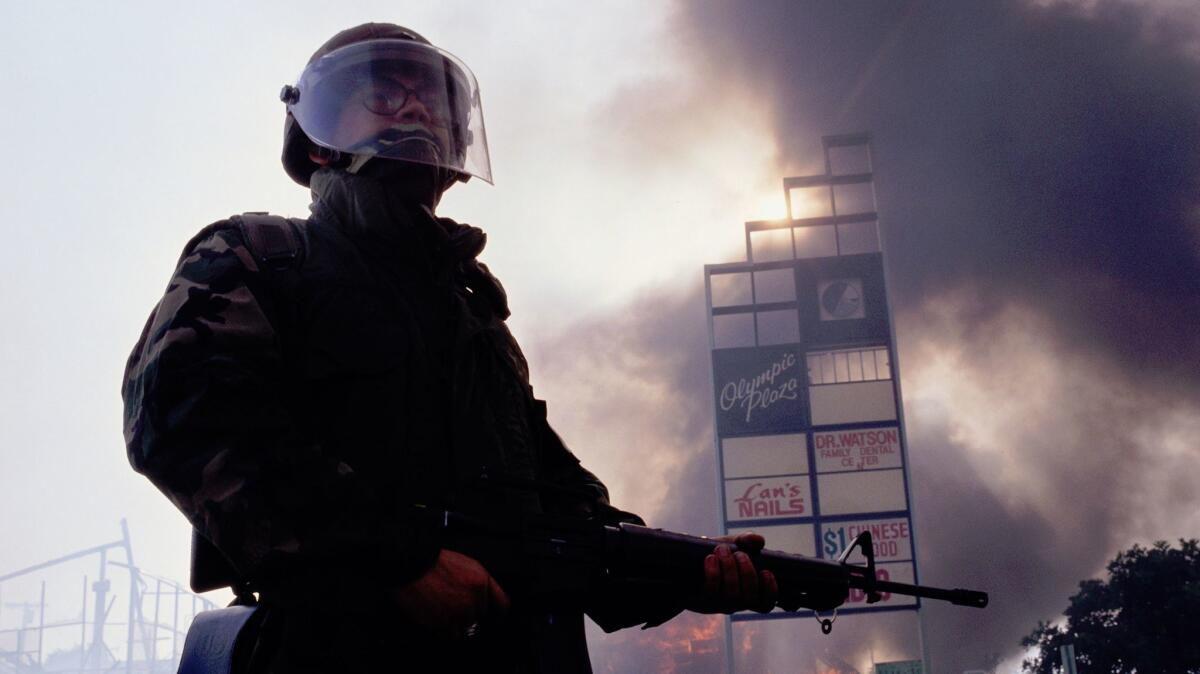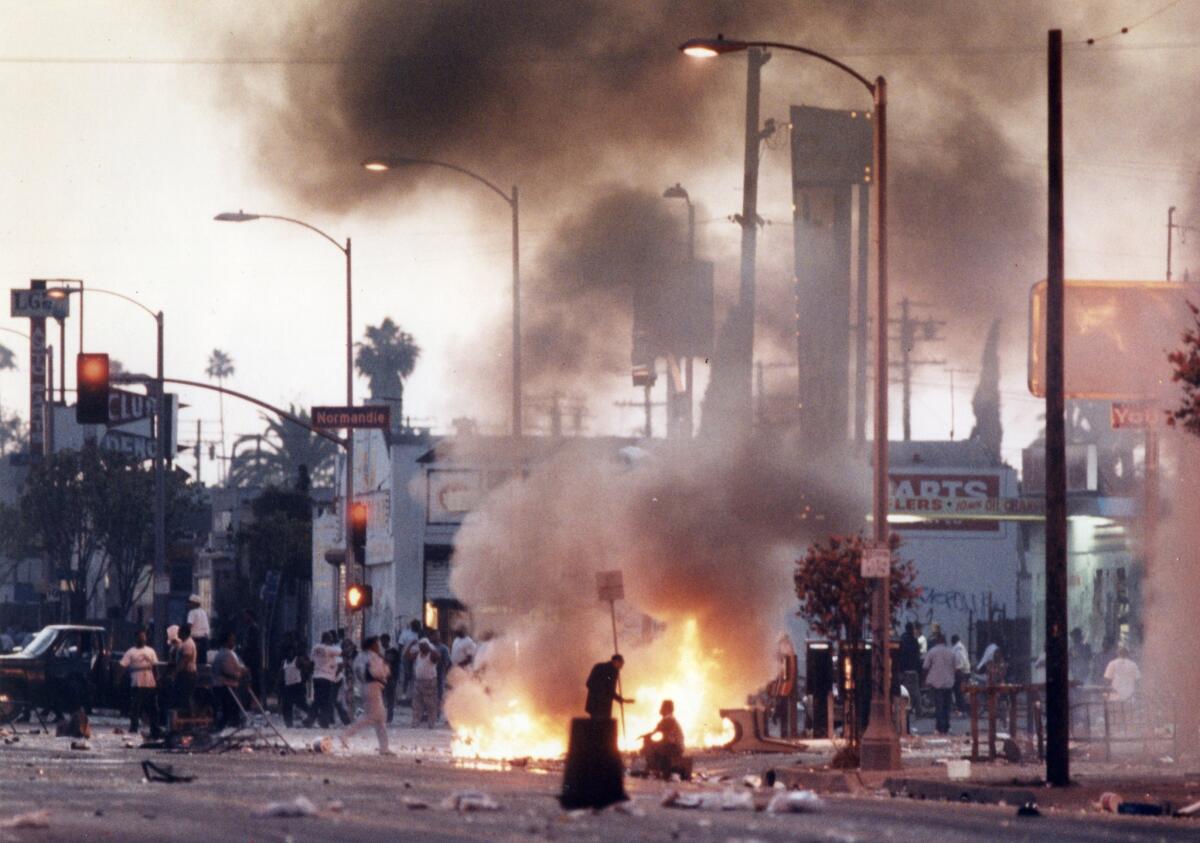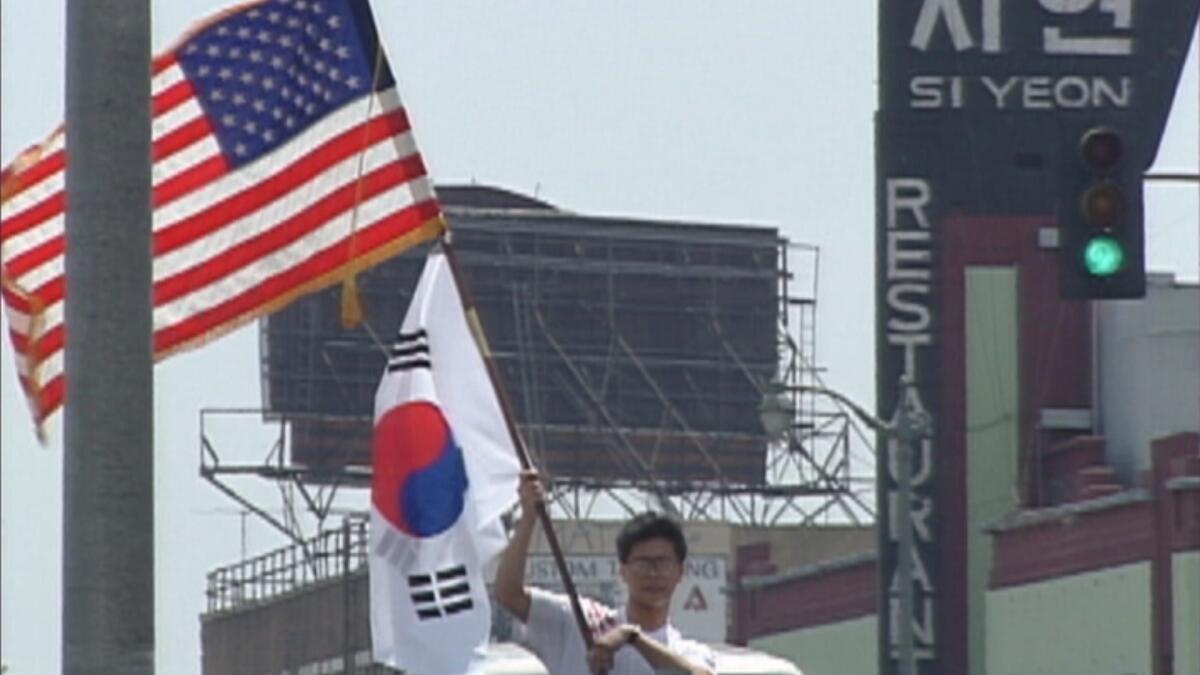Angelenos talking to Angelenos: Covering the L.A. riots when local news still mattered

Plumes of smoke blew in from Hollywood Boulevard, sending ash across Franklin Avenue in dirty flurries, depositing a thick dusting of gray silt on our window sills.
Even though the burning and looting was happening just down the street, most everyone in our East Hollywood apartment complex — and the buildings on either side of us — was following news of the 1992 L.A. riots via local broadcasts.
CNN was still a luxury meant for those who could afford cable. Digital news wasn’t a thing yet. And social media? Nonexistent. Cellphones were still car phones, and none of my broke, barely twentysomething friends had those.
Chopper Bob hovered above Florence and Normandie ... desperately asking where the police were ... anchor Kent Shocknek fell uncharacteristically silent.

A cacophony of broadcasts in English and Spanish blared out of apartment windows, the voices of KTLA’s Stan Chambers and KTTV’s Hal Eisner echoing between buildings, amplifying the chaos and adding to the terrifyingly surreal nature of what was happening.
Race relations had hit a boiling point and Los Angeles had exploded, the TV announcers said. Angry mobs were setting businesses on fire, attacking motorists, looting. People were dying. The LAPD was nowhere to be found.
Places we recognized — the Sears on St. Andrews and Santa Monica, that shoddy car stereo/LoJack shop on La Brea — became alienating scenes of chaos and violence, while a thick layer of smoke settled oppressively atop the entire city.
Local newscasters we’d grown up with appeared just as shocked. It was Angelenos talking to Angelenos — reporters whose names you knew, covering a city they knew, with an army of camera crews. This was a family tragedy.
Chopper Bob hovered above Florence and Normandie for KCOP, desperately asking where the police were as Reginald Denny was beaten (neighborhood citizens saved him) in perhaps the uprising’s most iconic moment. Seasoned anchor Kent Shocknek fell uncharacteristically silent as he reported on an LAPD cruiser that was being flipped on its roof by protesters who then set it on fire right in front of Parker Center, the downtown LAPD command center.
For anyone who lived through the riots of 1992, who was close enough to live under curfew, feel the rumble of tanks rolling through the city, witness national guard patrol their neighborhood with machine guns, today’s Los Angeles seems like nothing short of a miracle.

This must sound dramatic, maybe even absurd, for those who arrived here after the city and police force were rebuilt. It means reconciling those old images of citywide looting, Koreatown gunfights and motorists pulled from cars and beaten with today’s L.A. of high rents, lower crime and luxury condo complexes radiating outward from downtown.
But it happened, exactly 25 years ago, on April 29. L.A. was on fire for four days, ignited by a fury so intense it produced one of the most deadly, destructive and widespread riots in American history. And because of where it took place — the media and entertainment capitol of the world — the anarchy was not only televised, it was shot, professionally, from every angle possible.
Even in a time of deep crisis, Los Angeles knew how to capture its own downfall for a national audience.
But just as the physical world of L.A. and its culture has changed over the last 25 years, so has the media environment that is the city’s stock in trade.
If there were a riot today, (and according to a new poll, a majority of those asked believe there will be another one within five years), it would surely be covered through the prism of social media and citizen journalism. Shaky clips shot on cellphones, posted on Facebook, picked up by CNN, played on loop. Local news would of course be there, but like most forms of journalism in the digital age, they have a fraction of the resources they did back when L.A. exploded.
This isn’t to say the local news back then was filled with insightful analysis — “if it bleeds, it leads” was a popular phrase about the 6 and 11 p.m. newscasts. But they did have reporters and photographers on the ground and in the air who knew the city, and that made all the difference.
“L.A. was known for having the best local news teams in the nation,” says Zoey Tur, known in 1992 as one of the city’s premier reporters from the air, Chopper Bob. “Unlike Chicago or New York, we’d covered earthquakes, floods, fires, car chases. We knew how to move across a huge city. We knew how to cover L.A.”
CNN was still a luxury meant for those who could afford cable. Digital news wasn’t a thing yet. And social media? Nonexistent.
Local news footage of the unrest is now the backbone of multiple documentaries commemorating the riot’s 25th anniversary: ABC’s “Let It Fall,” National Geographic’s “LA 92,” A&E’s “L.A. Burning: The Riots 25 Years Later,” Showtime’s “Burn … Burn.”
The fact that there are so many riot documentaries — at least a half dozen — airing on television this month, and that each film features predominantly different material, is a testament to the sheer volume of footage shot during an uprising that took at least 60 lives, destroyed more than 1,000 buildings and amassed more than $1 billion in damages.
Even those of us who remember the acrid smell of burning buildings and the terrifying, nonstop sound of vigilante gunfire can’t help but experience the riots from several new angles while watching the films.
Interspersed in all the footage and imagery are indelible scenes of the uprising — Rodney King clubbed, kicked and tased by white LAPD officers near the corner of Foothill Boulevard and Osborne, sobs and cries of outrage outside of the Simi Valley courthouse when those same officers were acquitted, prayers and anger at the First AME Church just off the 10 Freeway, Denny dragged out of his truck by an angry mob in South L.A.
For a lifelong Angeleno with deep roots in the city, it’s hard to watch ... and even more difficult to stop watching. There’s no turning away when L.A. is part of your DNA.
My 101-year-old aunt grew up in Highland Park. My mom in Leimert Park. I was shaped by the smoggy, drab San Fernando Valley of the 1970s and ’80s (explains a lot, but that’s for another story).
We always knew L.A. as a layered and complex place, evident through the family’s successes, failures and hardships. But I didn’t understand how truly flawed it was until the ’92 riots.
The newscasts were at odds with ideas the rest of the country had always had about Los Angeles.
L.A. was shorthand for movie magic, year-round sunshine and hot blonds playing volleyball in bandage-sized bikinis. It was considered neutral space, free of the baggage of slavery and segregation that plagued the South, or the old-money caste system of the East Coast.
No matter where or what you came from, anyone could reinvent themselves in Los Angeles. It was the closest one could come to an even playing field, even if it is vapid, shallow and obsessed with its weight.
The anger, rage and injustice captured on national news clips during the L.A. riots didn’t fit that picture. St Louis or Detroit? Maybe. But not L.A.
As an Angeleno, watching similar footage 25 years later isn’t so much therapeutic as it is an affirmation: This indeed happened.
You can view it as the second wave of the Watts riots or a precursor to the uprisings in Ferguson or Baltimore. All were spurred by the same endemic problem America just can’t shake — a double standard based on race.
But what that old news footage can’t capture is the sick, eerie silence of Los Angeles on the first day of the riots. It was a city void of sirens (the police, fire department and paramedics were grounded), traffic jams, leafblowers, school kids. Streets emptied.
It was a stunned silence alien to L.A., except in those rare, few frozen seconds after a major earthquake. And we’d have one of those within two years, hardly enough time to heal.
Here’s the part where I’m supposed to say Los Angeles is way better off than it was, but we still have a long way to go. There’s still glaring inequity, racial division, police shootings of unarmed civilians.
My teenage son knows L.A. as a different city than I do: cleaner, safer, a place seemingly too advanced to devolve into such chaos.
Thank God the cameras were there to remind us of what we should never forget.
Twitter: @lorraineali
ALSO
'Look what happens when we don't talk to each other': Korean American filmmakers' L.A. riots stories
Netflix's 'Rodney King' has Spike Lee and his muse looking back
Trio of L.A. riot documentaries look back to 1992
Korean American filmmakers deeply affected by the L.A. riots
John Singleton looks back on the 1992 L.A. riots in new documentary
'History happened here': Oscar winner John Ridley revisits the 1992 riots in his new documentary
The complete guide to home viewing
Get Screen Gab for everything about the TV shows and streaming movies everyone’s talking about.
You may occasionally receive promotional content from the Los Angeles Times.




